Fault Detection Algorithm for Multiple-Simultaneous Refrigerant Charge and Secondary Fluid Flow Rate Faults in Heat Pumps
Abstract
:1. Introduction
2. Experimental Setup and Methodology
3. Results and Discussions
3.1. Performance of the Heat Pump Unit According to the Various Faults
3.1.1. Simultaneous Refrigerant Charge Fault and IDHX Secondary Fluid Flow Rate Fault
3.1.2. Simultaneous Faults in the Refrigerant Charge and Secondary Fluid Flow Rate of Outdoor Heat Exchanger
3.1.3. Simultaneous Faults in the Refrigerant Charge and Secondary Fluid Flow rate of Outdoor Heat Exchanger and Indoor Heat Exchanger
3.2. Development of Fault Detection and Diagnosis Algorithm
4. Conclusions
- Three faults occurring simultaneously greatly affect the heat pump’s performance compared to the occurrence of two simultaneously combined faults. At 70% refrigerant charge ratio (RCR), 60% IFRF and 60% OFRF, capacity and COP of the heat pump unit decreased, respectively, by 5.7% and 11.6% more than at 70% RCR and 60% IFRF. Furthermore, the heat pump’s capacity and COP decreased, respectively, by 8% and 5.9% at 70% RCR, 60% IFRF and 60% OFRF more than at 70% RCR and 60% OFRF.
- An FDD algorithm was developed to detect the simultaneous faults using multiple linear regression. The parameters used in the algorithm include discharge temperature of the compressor and the temperature difference of the secondary fluid across the IDHX and ODHX. The developed algorithm was able to detect simultaneous refrigerant charge fault and IFRF, simultaneous refrigerant charge fault and OFRF and simultaneous refrigerant charge fault, IFRF and OFRF within error thresholds of ±7.3%, ±7.6% and ±7.7%, respectively.
- The proposed FDD model uses temperature sensors to detect and diagnose faults. This method is cheap and simple to use, compared to other FDD models that use thermal imaging models and quantitative model-based methods that demand complex mathematical models of the systems. Thermal imagining is fast, efficient and safe; however, the initial cost of purchasing thermal imaging cameras is high with low accuracy for temperature measurement due to different emissive properties of surfaces. Moreover, thermal imaging FDD methodologies are faster than the proposed methodology. Future studies will focus on developing FDD algorithms for simultaneous refrigerant charge and secondary fluid flow rate faults for heat pumps operating with variable speed compressors.
Author Contributions
Funding
Data Availability Statement
Acknowledgments
Conflicts of Interest
Nomenclature
| COP | Coefficient of performance |
| Cp | Specific heat capacity of water [kJ/kgK] |
| EEV | Electronic expansion valve |
| FDD | Fault detection and diagnosis |
| HVAC | Heating, Ventilation and Air Conditioning |
| HX | Heat exchanger |
| IFRF | Indoor heat exchanger secondary fluid flow rate fault |
| LPM | Secondary fluid flow rate [LPM] |
| LWT | Leaving water temperature [] |
| OD EWT | Outdoor heat exchanger entering water temperature [] |
| ODHX | Outdoor heat exchanger |
| OFRF | Outdoor heat exchanger secondary fluid flow rate fault |
| Q | Capacity [kW] |
| RCR | Refrigerant charge ratio |
| RTD | Resistance temperature detector |
| SFFR | Secondary fluid flow rate |
| Tdis | Discharge temperature of compressor [] |
| U | Uncertainty |
| W | Power consumption [kW] |
| x | Variable nominal value |
| Density of water [kg/m3] |
References
- Zhang, Z.; Dong, X.; Ren, Z.; Lai, T.; Hou, Y. Influence of refrigerant charge amount and EEV opening on the performance of a transcritical CO2 heat pump water heater. Energies 2017, 10, 1521. [Google Scholar] [CrossRef] [Green Version]
- Khan, I.; Capozzoli, A.; Corgnati, S.P.; Cerquitelli, T. Fault detection analysis of building energy consumption using data mining techniques. The mediterranean green energy forum 2013, MGEF-13. Energy Procedia 2013, 42, 557–566. [Google Scholar] [CrossRef] [Green Version]
- Li, Y.; O’Neill, Z. A critical review of fault modelling of HVAC systems in buildings. Build. Simul. 2018, 11, 953–957. [Google Scholar] [CrossRef]
- Gerrit, B.; Simon, T.; Baranski, M.; Müller, D. Real-world application of machine-learning-based fault detection trained with experimental data. Energy 2020, 198, 117323. [Google Scholar]
- Kim, W.; Katipamula, S. A review of fault detection and diagnostics methods for building systems. Sci. Technol. Built Environ. 2018, 24, 3–21. [Google Scholar] [CrossRef]
- Abuasbeh, M.; Madani, H. Fault detection and diagnosis for brine to water heat pump systems. In Proceedings of the 12th IEA Heat Pump Conference, Rotterdam, The Netherlands, 15–18 May 2017. [Google Scholar]
- Yan, K.; Zhiwei Ji, Z.; Shen, W. Online fault detection methods for chillers combining extended kalman filter and recursive one-class SVM. Neurocomputing 2017, 228, 205–212. [Google Scholar] [CrossRef] [Green Version]
- Gálvez, A.; Diez-Olivan, A.; Seneviratne, D.; Galar, D. Fault Detection and RUL Estimation for Railway HVAC Systems Using a Hybrid Model-Based Approach. Sustainability 2021, 13, 6828. [Google Scholar] [CrossRef]
- Buffa, S.; Fouladfar, M.H.; Franchini, G.; Lozano Gabarre, I.; Andrés Chicote, M. Advanced control and fault detection strategies for district heating and cooling systems—A review. Appl. Sci. 2021, 11, 455. [Google Scholar] [CrossRef]
- Nehasil, O.; Dobiášová, L.; Mazanec, V.; Široký, J. Versatile AHU fault detection—Design, field validation and practical application. Energy Build. 2021, 237, 110781. [Google Scholar] [CrossRef]
- Taal, A.; Itard, L. Fault detection and diagnosis for indoor air quality in DCV systems: Application of 4S3F method and effects of DBN probabilities. Build Environ. 2020, 174, 106632. [Google Scholar] [CrossRef]
- Granderson, J.; Lin, G.; Harding, A.; Im, P.; Chen, Y. Building fault detection data to aid diagnostic algorithm creation and performance testing. Sci. Data 2020, 7, 1–14. [Google Scholar] [CrossRef]
- Park, Y.-J.; Fan, S.-K.S.; Hsu, C.-Y. A review on fault detection and process diagnostics in industrial processes. Processes 2020, 8, 1123. [Google Scholar] [CrossRef]
- Shamandi, S.A.; Rasouli Jazi, S. Fault detection in compression refrigeration system with a fixed orifice and rotary compressor. J. Mech. Eng. 2020, 4, 277–286. [Google Scholar]
- Zhao, Y.; Wang, S.; Xiao, F. A statistical fault detection and diagnosis method for centrifugal chillers based on exponentially-weighted moving average control charts and support vector regression. Appl. Therm. Eng. 2013, 51, 560–572. [Google Scholar] [CrossRef]
- Sellami, A.; Aridhi, E.; Mzoughi, D.; Mami, A. Performance of the Bond Graph Approach for the detection and localization of faults of a refrigerator compartment containing an ice quantity. Int. J. Air Cond. Refrig. 2018, 26, 1850028. [Google Scholar] [CrossRef]
- Sun, J.; Im, P.; Bae, Y.; Munk, J.; Kuruganti, T.; Fricke, B. Dataset of low global warming potential refrigerant refrigeration system for fault detection and diagnostics. Sci. Data 2021, 8, 144. [Google Scholar]
- Li, B.; Cheng, F.; Cai, H.; Zhang, X.; Cai, W. A semi-supervised approach to fault detection and diagnosis for building HVAC systems based on the modified generative adversarial network. Energy Build. 2021, 246, 111044. [Google Scholar] [CrossRef]
- Bellanco, I.; Fuentes, E.; Vallès, M.; Salom, J. A review of the fault behavior of heat pumps and measurements, detection and diagnosis methods including virtual sensors. J. Build. Eng. 2021, 39, 102254. [Google Scholar] [CrossRef]
- Dudley, S.; Dey, M.; Rana, S. Semi-supervised learning techniques for automated dault detection and diagnosis of HVAC system. In Proceedings of the IEEE International Conference on Tools with Artificial Intelligence (ICTAI-2018), Volos, Greece, 5–7 November 2018. [Google Scholar]
- Eom, Y.H.; Yoo, J.W.; Hong, S.B.; Kim, M.S. Refrigerant charge fault detection method of air source heat pump system using convolutional neural network for energy saving. Energy 2019, 187, 115877. [Google Scholar] [CrossRef]
- Zhao, X.; Yang, M.; Li, H. Field implementation and evaluation of a decoupling-based fault detection and diagnosis method for chillers. Energy Build. 2014, 72, 419–430. [Google Scholar] [CrossRef]
- Han, H.; Gu, B.; Hong, Y.; Kang, J. Automated FDD of multiple-simultaneous faults (MSF) and the application to building chillers. Energy Build. 2011, 43, 2524–2532. [Google Scholar] [CrossRef]
- Boahen, S.; Mensah, K.; Nam, Y.; Choi, J.M. Fault detection methodology for secondary fluid flow rate in a heat pump unit. Energies 2020, 13, 2974. [Google Scholar] [CrossRef]
- Miyata, S.; Lim, J.; Akashi, Y.; Kuwahara, Y.; Tanaka, K. Fault detection and diagnosis for heat source system using convolutional neural network with imaged faulty behavior data. Sci. Technol. Built Environ. 2020, 26, 52–60. [Google Scholar] [CrossRef] [Green Version]
- Mowris, R.J.; Blankenship, A.; Jones, E. Field Measurements of Air Conditioners with and without TXVs. ACEEE Summer Study Proc. 2004, 1, 212–227. [Google Scholar]
- Roth, K.; Westphalen, D.; Broderick, J. Residential Central AC Fault Detection & Diagnostics. ASHRAE J. 2019, 48, 96–97. [Google Scholar]
- International Standard. ISO 13256-2, 1998. Water-Source Heat Pumps—Testing and Rating for Performance Part 2 Water-to-Water and Brine-to-Water Heat Pumps; ISO: Geneva, Switzerland, 1998. [Google Scholar]
- KEMCO. NR GT 101, 2008, Water-to-Water Ground Source Heat Pump; NRGT: Yongin, Korea, 2008. [Google Scholar]
- ASHRAE. ASHRAE Guideline 2. Engineering Analysis of Experimental Data; ASHRAE: Atlanta, GA, USA, 1986. [Google Scholar]
- Boahen, S.; Lee, K.H.; Choi, J.M. Refrigerant charge fault detection and diagnosis algorithm for water-to-water heat pump unit. Energies 2019, 12, 545. [Google Scholar] [CrossRef] [Green Version]
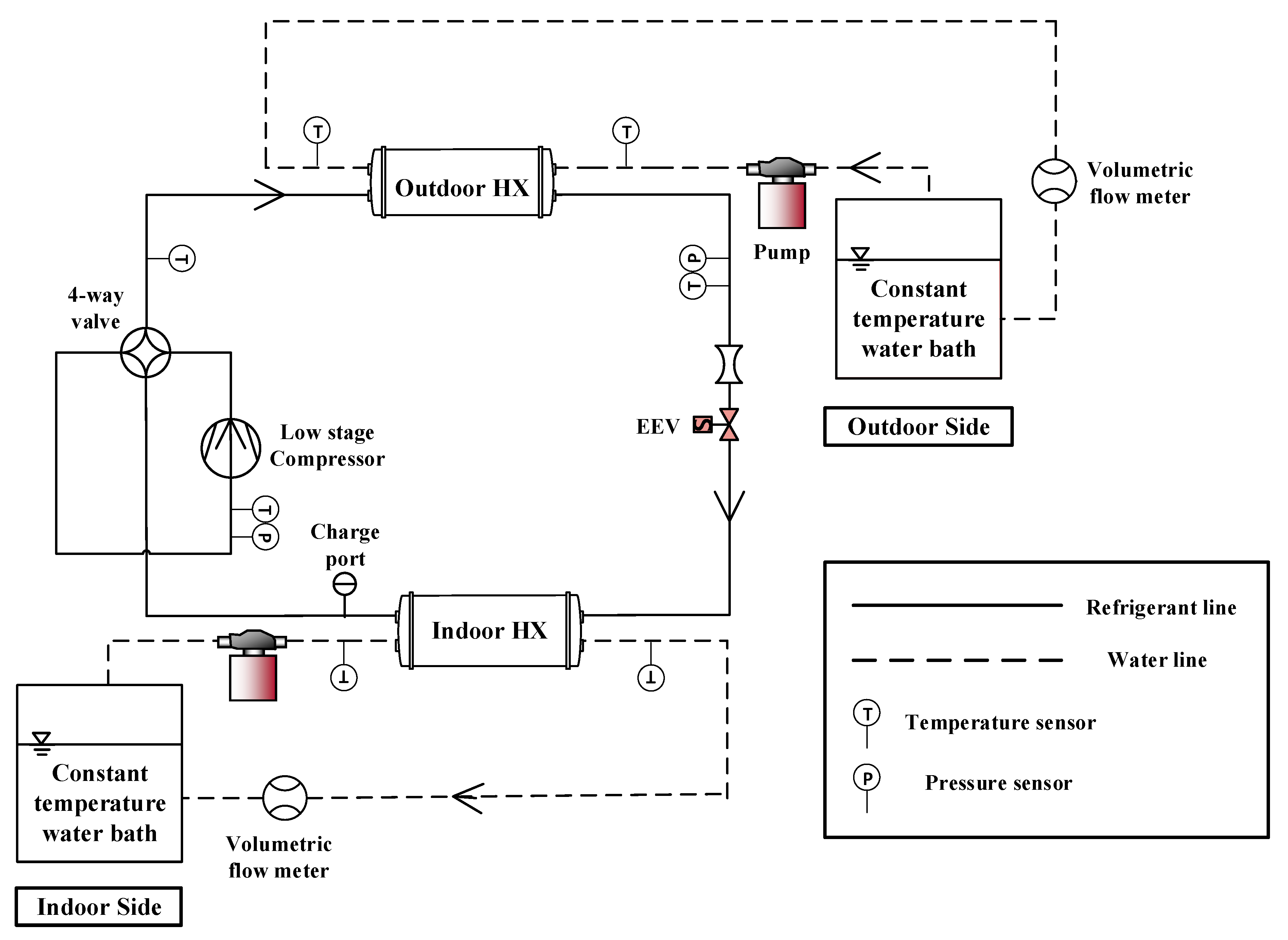
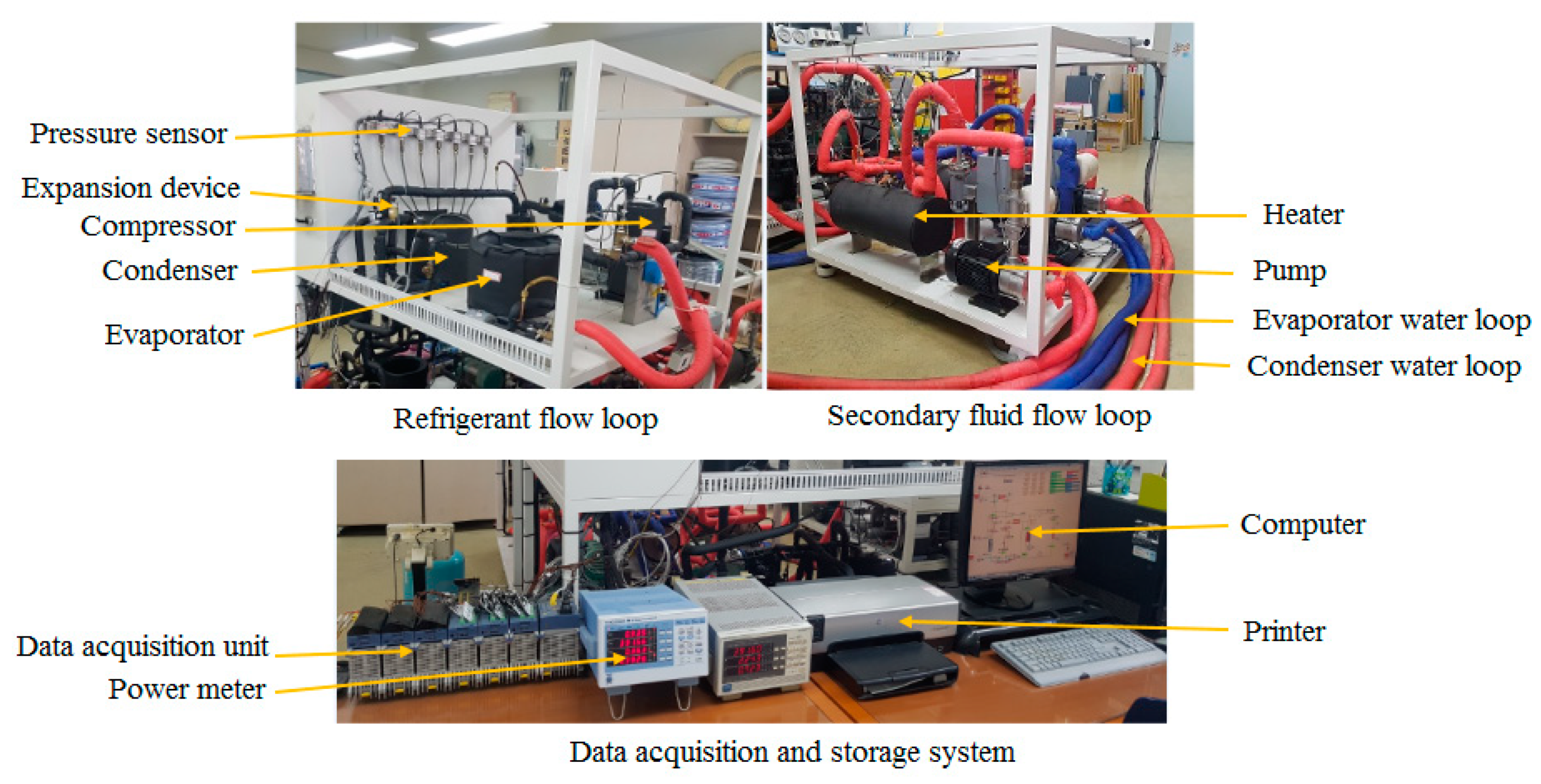


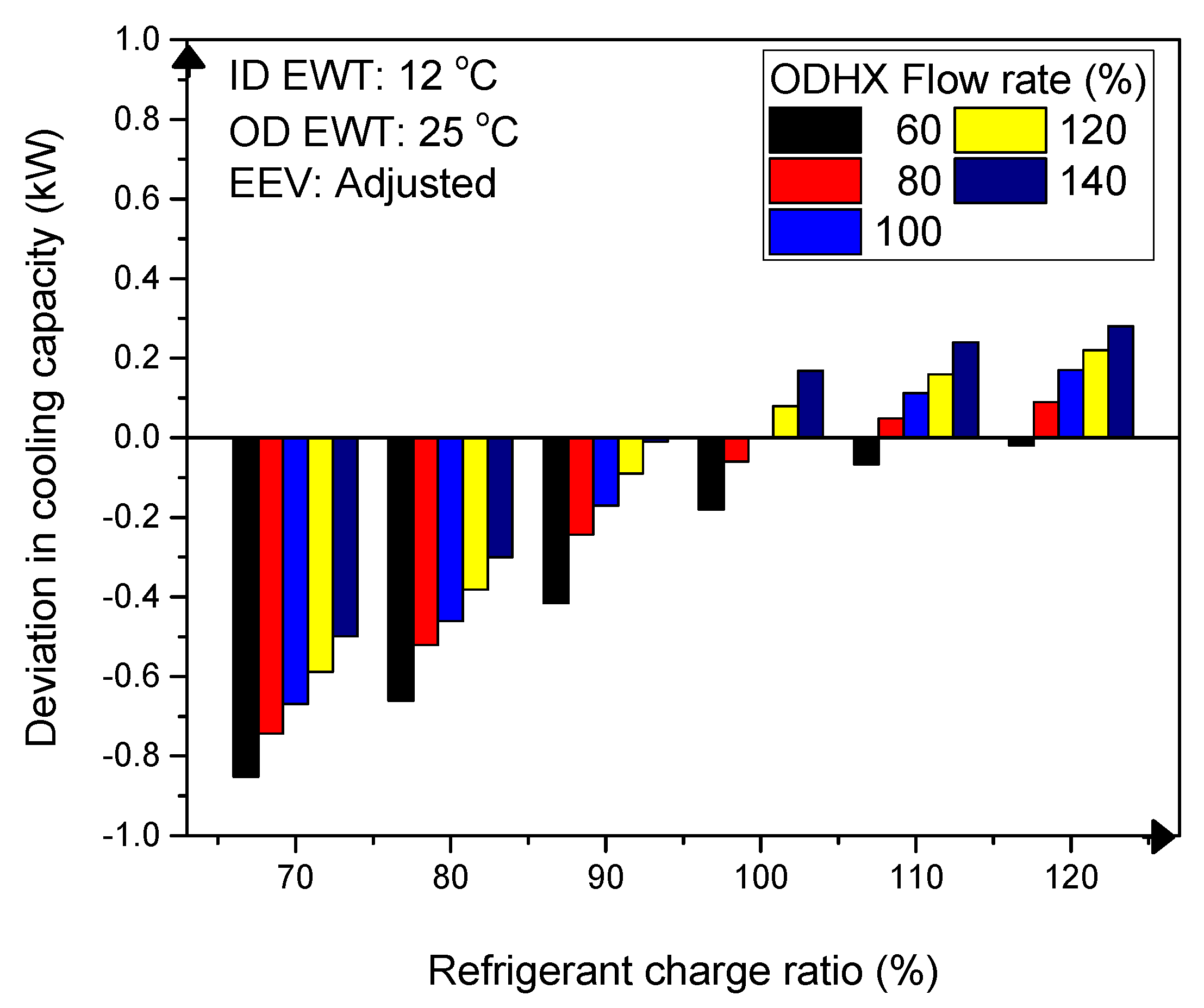

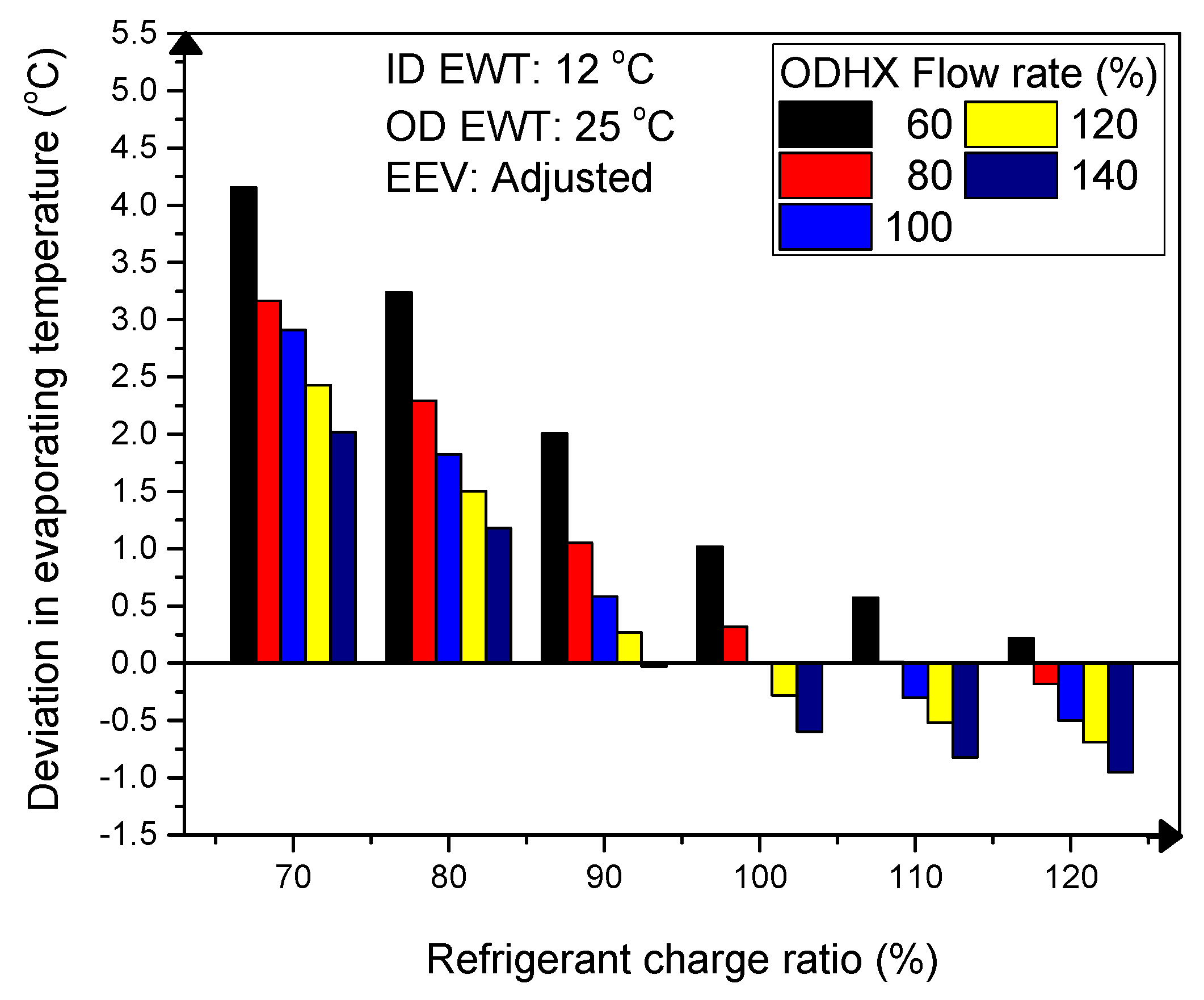
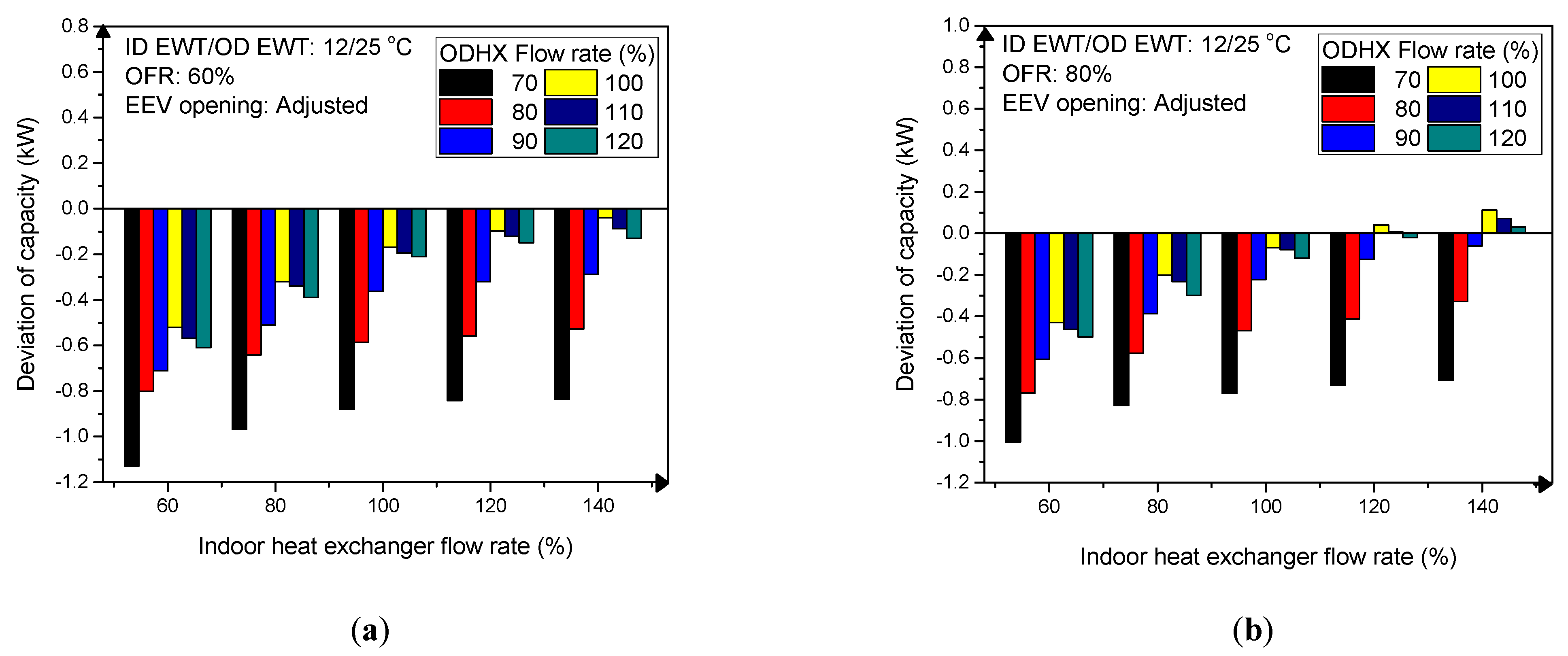


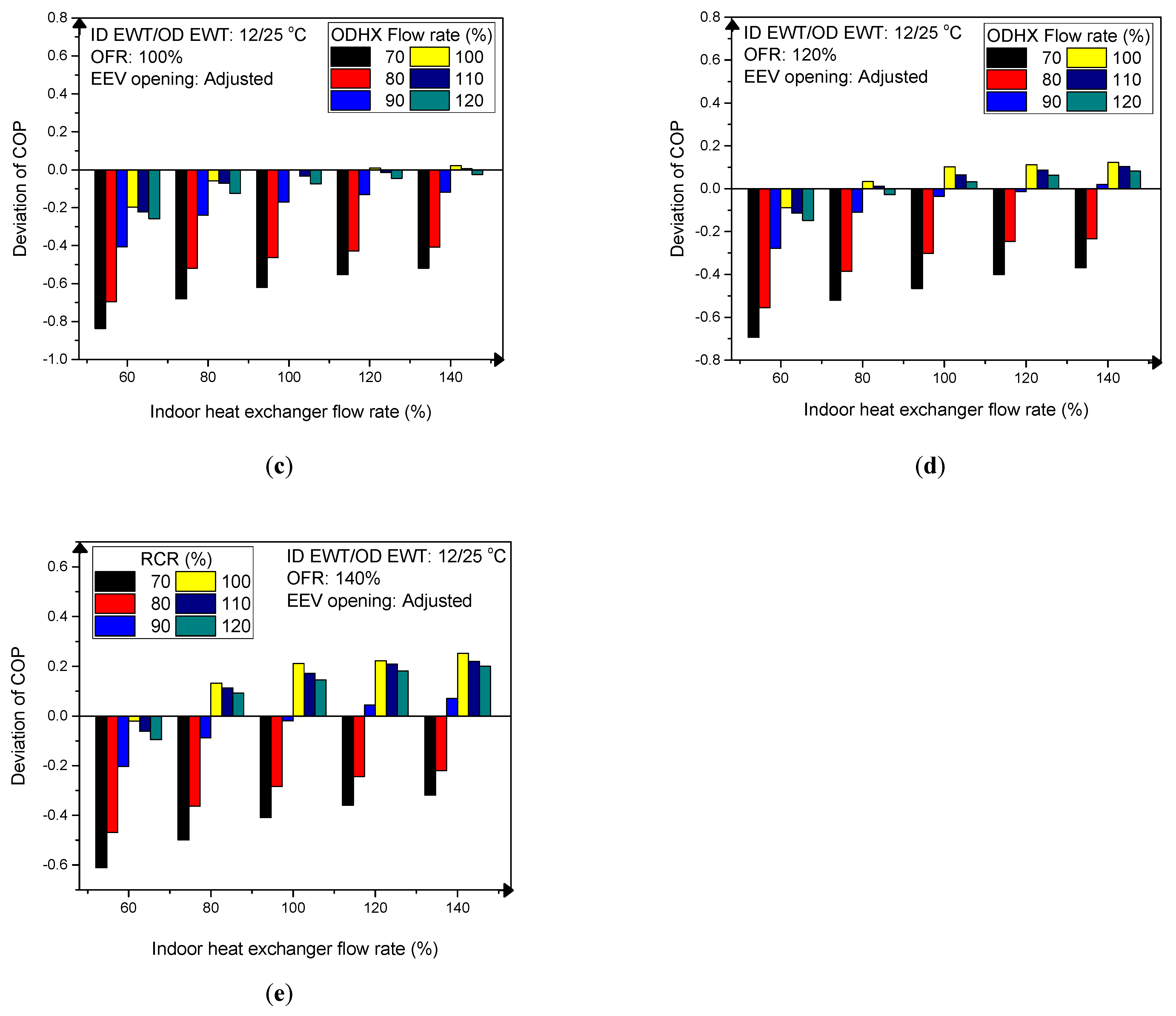
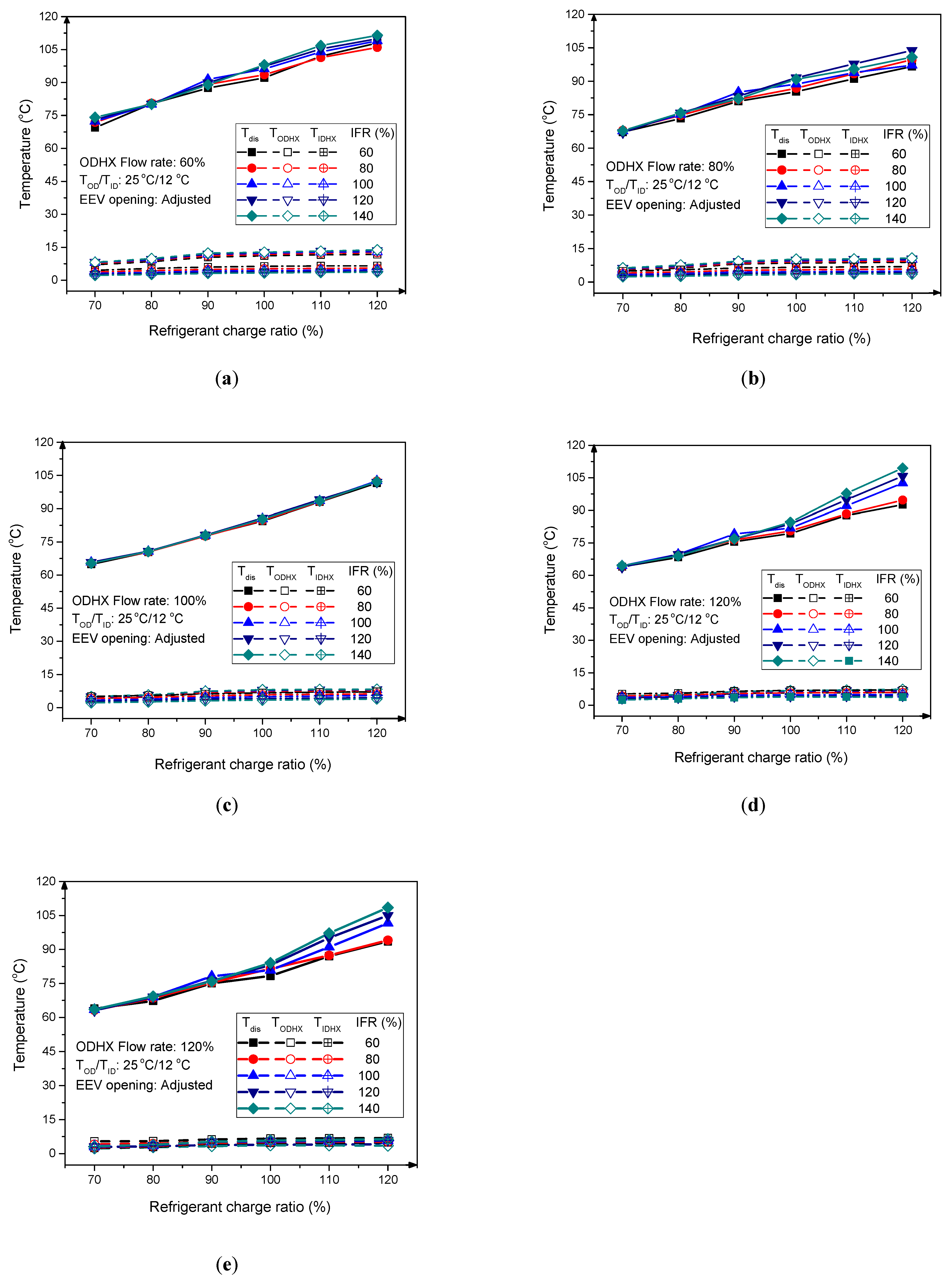
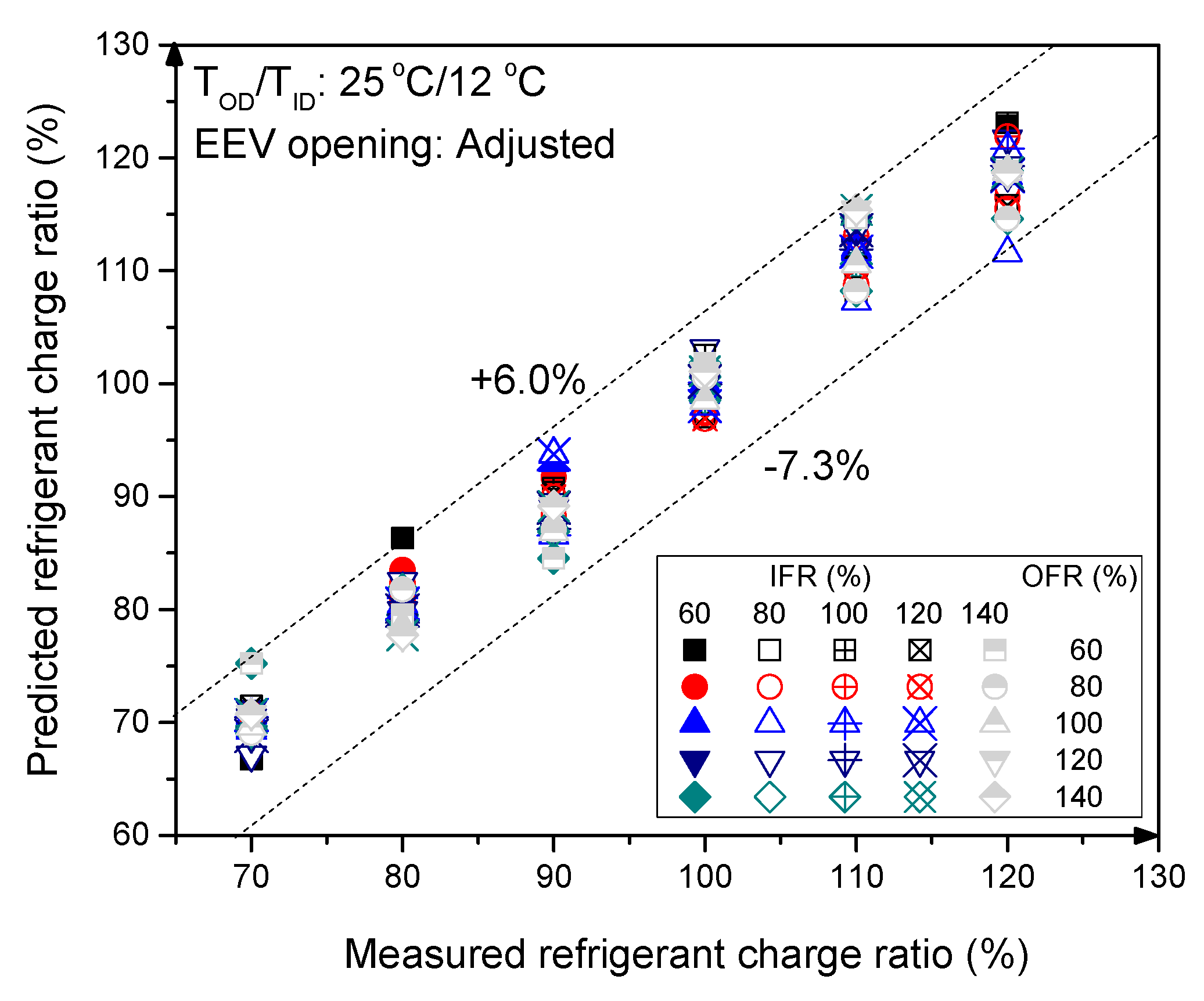
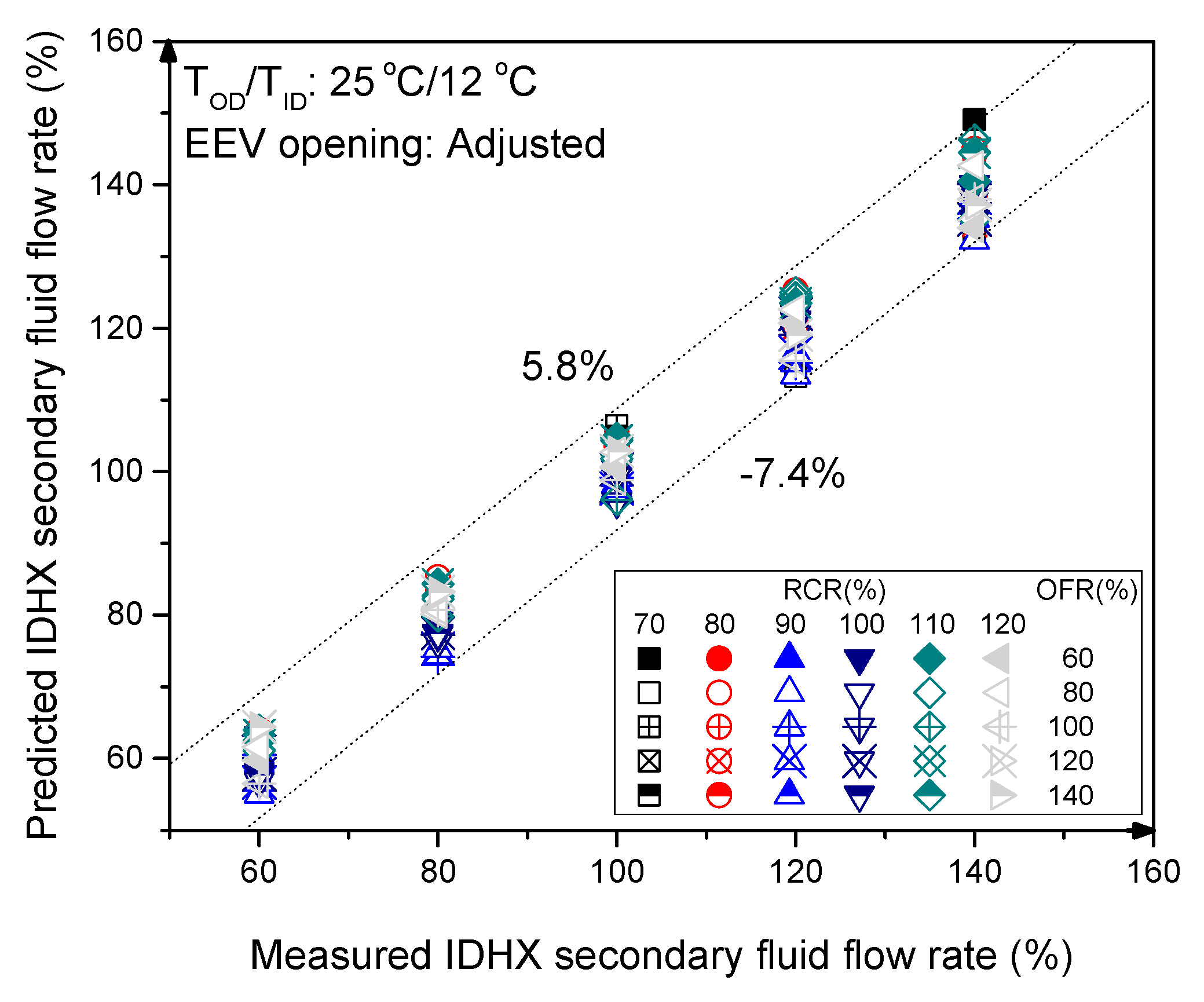


| Variable | Base Condition | Test Range |
|---|---|---|
| Mode of operation | Cooling | Cooling |
| Type of refrigerant | R410A | R410A |
| Refrigerant charge amount (kg) | 4.7 | 4.7 |
| Ratio of refrigerant charge amount (%) | 100 | 70, 80, 90, 100, 110, 120 |
| Indoor heat exchanger EWT | 12 | 12 |
| Outdoor heat exchanger EWT | 25 | 20, 25, 30, 35 |
| Secondary fluid flow rate of ODHX (LPM) | 8 | 60, 80, 100, 120, 140 |
| Secondary fluid flow rate of IDHX (LPM) | 8 | 60, 80, 100, 120, 140 |
| Sensor | Accuracy |
|---|---|
| Pressure transducer | ±0.5% |
| T-Type thermocouple | ±0.2 |
| Power meter | ±0.5% of reading |
| Mass flow meter | ±0.5% of reading |
| Volumetric flowmeter | ±2% of reading |
| RTD sensor | ±0.15 |
| SF | Refrigerant Charge Fault | Fault in the Flow Rate of the IDHX Secondary Fluid | Fault in the Flow Rate of the ODHX Secondary Fluid | Cooling Capacity | COP |
|---|---|---|---|---|---|
| 1. | Refrigerant overcharge | Reduced IFRF | Increased OFRF |  |  |
| 2. | Refrigerant overcharge | Reduced IFRF | Reduced OFRF |  |  |
| 3. | Refrigerant overcharge | Increased IFRF | Increased OFRF |  |  |
| 4. | Refrigerant overcharge | Increased IFRF | Reduced OFRF |  |  |
| 5. | Refrigerant undercharge | Reduced IFRF | Increased OFRF |  |  |
| 6. | Refrigerant undercharge | Reduced IFRF | Reduced OFRF |  |  |
| 7. | Refrigerant undercharge | Increased IFRF | Increased OFRF |  |  |
| 8. | Refrigerant undercharge | Increased IFRF | Reduced OFRF |  |  |
| Coefficients | RCR Correlation | IFR | OFR |
|---|---|---|---|
| a | −152.2 | −281.9 | −372.8 |
| b | −14.43 | −31.63 | −49.67 |
| c | −0.5533 | −0.4396 | 0.9043 |
| d | −4.863 | −45.12 | −2.046 |
| e | 0.2156 | 3.5198107 | 0.6293 |
| f | 5.987 | 14.42 | 15.48 |
| g | −0.0373 | −0.08216 | −0.08193 |
| h | −0.2563 | 0.5873 | 0.969 |
| i | 0.2438 | 0.3473 | 0.1717 |
| j | 0.05946 | −0.2359 | −0.191 |
Publisher’s Note: MDPI stays neutral with regard to jurisdictional claims in published maps and institutional affiliations. |
© 2021 by the authors. Licensee MDPI, Basel, Switzerland. This article is an open access article distributed under the terms and conditions of the Creative Commons Attribution (CC BY) license (https://creativecommons.org/licenses/by/4.0/).
Share and Cite
Boahen, S.; Mensah, K.; Anka, S.K.; Lee, K.H.; Choi, J.M. Fault Detection Algorithm for Multiple-Simultaneous Refrigerant Charge and Secondary Fluid Flow Rate Faults in Heat Pumps. Energies 2021, 14, 3877. https://doi.org/10.3390/en14133877
Boahen S, Mensah K, Anka SK, Lee KH, Choi JM. Fault Detection Algorithm for Multiple-Simultaneous Refrigerant Charge and Secondary Fluid Flow Rate Faults in Heat Pumps. Energies. 2021; 14(13):3877. https://doi.org/10.3390/en14133877
Chicago/Turabian StyleBoahen, Samuel, Kwesi Mensah, Selorm Kwaku Anka, Kwang Ho Lee, and Jong Min Choi. 2021. "Fault Detection Algorithm for Multiple-Simultaneous Refrigerant Charge and Secondary Fluid Flow Rate Faults in Heat Pumps" Energies 14, no. 13: 3877. https://doi.org/10.3390/en14133877






